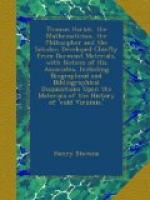The fleet had a prosperous voyage by the then usual route of the West Indies and fell in with the main of Florida on the 20th of June, made and named Cape Fear on the 23d, and a first landing the next day, and on the 26th came to Wococa where Amadas and Barlow had been the year before. They disembarked and at first mistook the country for Paradise. July was spent in surveying and exploring the country, making the acquaintance of the natives, chiefly by means of two Indians that had been taken to England and brought back able to speak English. On the 5th of August Master John Arundel, captain of one of the vessels, was sent back to England, and on the 25th of August Admiral Grenville, after a sojourn of two months in Virginia, took his leave and returned, arriving at Plymouth on the 18th of October. There were left in Virginia as Raleigh’s ‘First Colonie,’ one hundred and nine men. They remained there one whole year and then, discontented, returned to England in July 1586 in Sir Francis Drake’s fleet coming home victorious from the West Indies.
One of these 109 men was Thomas Hariot the Author of the Report of Virginia. Another was John White the painter. To these two earnest and true men we owe, as has been said, nearly all we know of ’Ould Virginia.’ Their story is briefly told by Hakluyt.
Sir Francis Drake in the true spirit of friendship went out of his way to make this call on the Colony of his friend Raleigh. He found them anything but contented and prosperous. They had long been expecting supplies and reinforcements from home, which not arriving, on the departure of Drake’s fleet becoming dejected and homesick, they petitioned the Governor for permission to return. Immediately after their departure a ship arrived from Raleigh, and fourteen days later Sir Richard Grenville himself returned with his fleet of three ships, new planters and stores of supplies, only to find the Colony deserted and no tidings to be had. Leaving twenty men to hold possession the Admiral made his way back to England.
It has already been stated how and under what circumstances the epitome of the labours and surveys of Hariot came to be printed, but it may be well to show how it came to be united with John White’s drawings and republished a year or two later as the first part of De Bry’s celebrated collections of voyages. Hakluyt returned to Paris at the end of 1584. and remained there, perhaps with an occasional visit to




